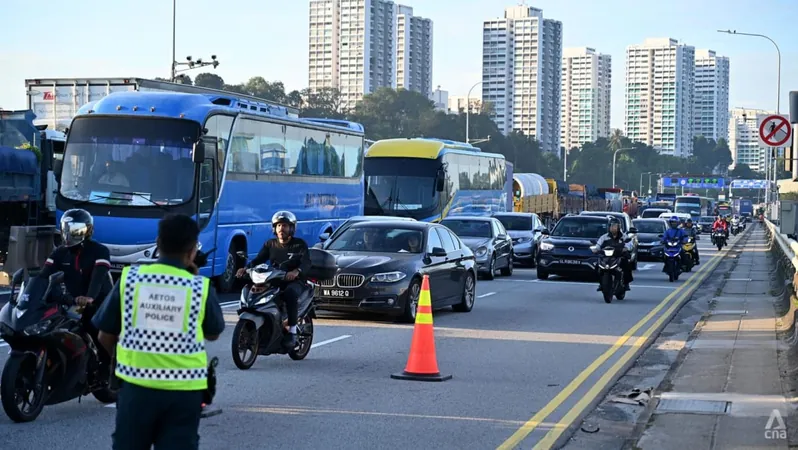
Will the Ambitious Johor-Singapore Special Economic Zone Live Up to Expectations?
2025-01-13
Author: Siti
Introduction
The Johor-Singapore Special Economic Zone (JS-SEZ) is emerging as one of the most ambitious cross-border economic initiatives in Southeast Asia. Since its official announcement in October 2023, the buzz around the JS-SEZ has intensified following the signing of a Memorandum of Understanding (MOU) in January last year and the recent updates shared during the Malaysia-Singapore Leaders' Retreat.
Spanning an impressive 3,571 square kilometers—approximately four times the size of Singapore and nearly double that of China's Shenzhen—the JS-SEZ is set to house nine flagship zones tailored to various economic sectors, including Johor Bahru City Centre, Iskandar Puteri, Desaru, and Pengerang Integrated Petroleum Complex. The ambition behind this venture is striking, with goals to establish 50 projects and create 20,000 skilled jobs within the first five years, ultimately aiming for 100 projects within the next decade. Such growth is projected to contribute a staggering US$28 billion annually to Malaysia's GDP over the next ten years, according to Malaysian Economy Minister Rafizi Ramli.
The Promising Aspects
One of the strengths of the JS-SEZ is its strategic segmentation into distinct zones, which can facilitate synergies among similar industries, potentially fostering self-sustaining economic ecosystems. Furthermore, the initiative offers a special 5% corporate tax rate for up to 15 years for firms engaging in high-value sectors such as artificial intelligence and aerospace, alongside tailored incentives for flagship zones. Additionally, a reduced income tax rate of 15% for "knowledge workers" and lowered entertainment duties add further appeal for potential investors.
Setting clear and achievable milestones—such as the goal of 50 projects in five years—will be crucial for maintaining investor engagement. While specifics about these projects are still forthcoming, there is potential for smaller, innovative ventures to contribute significantly to the ecosystem.
The focus on talent acquisition is another critical component of the JS-SEZ’s strategy. With an emphasis on high-value sectors such as the digital economy, aviation, and financial services, Malaysia aims to cultivate a skilled workforce to meet the demands of a competitive global landscape.
Challenges Ahead
Despite these promising aspects, several challenges must be overcome for the JS-SEZ to achieve its lofty ambitions. A key priority is the timely establishment of the Invest Malaysia Facilitation Centre-Johor, a one-stop shop designed to simplistically guide companies seeking to invest in or expand operations within the SEZ.
Regulatory clarity is also paramount, as businesses require a comprehensive understanding of rules, particularly those surrounding labor laws and work permits, to make informed investment decisions. Proactively addressing any initial obstacles can significantly bolster confidence among prospective investors.
Infrastructure development remains another concern. Minister Rafizi has proposed a project-by-project approach to infrastructure within the JS-SEZ, which poses risks of fragmented development. By enhancing connectivity through broader infrastructure initiatives in Johor—such as the upcoming 4km Johor-Singapore Rapid Transit System (RTS), expected to launch by late 2026—investors' prospects could improve remarkably.
Moreover, a balanced focus is needed to accommodate both high-tech sectors and traditional industries seeking to capitalize on a larger domestic market and favorable tax rates. Establishing a clear roadmap for these sectors could create a solid foundation for investments.
Finally, transparent accountability measures will be essential in evaluating progress. Regular assessments of the JS-SEZ can help determine if the projects are meeting job creation targets and if the flagship zones are flourishing as intended.
Looking Forward
The success of the JS-SEZ holds significant implications for both Malaysia and Singapore, strengthening economic ties and potentially transforming the region into a global economic hub. Positive sentiments from the leadership of both nations have made this cross-border endeavor credible, and while initial challenges are to be expected, adaptability will be key.
In conclusion, the faster that businesses, policymakers, and regulators can align their efforts, the more effectively they can harness the potential of the JS-SEZ, paving the way for an economically prosperous future for both countries.
As watchers of this ambitious project, we can only wait and see if the Johor-Singapore SEZ will indeed meet its lofty expectations and become a beacon of success within the ASEAN region.

 Brasil (PT)
Brasil (PT)
 Canada (EN)
Canada (EN)
 Chile (ES)
Chile (ES)
 Česko (CS)
Česko (CS)
 대한민국 (KO)
대한민국 (KO)
 España (ES)
España (ES)
 France (FR)
France (FR)
 Hong Kong (EN)
Hong Kong (EN)
 Italia (IT)
Italia (IT)
 日本 (JA)
日本 (JA)
 Magyarország (HU)
Magyarország (HU)
 Norge (NO)
Norge (NO)
 Polska (PL)
Polska (PL)
 Schweiz (DE)
Schweiz (DE)
 Singapore (EN)
Singapore (EN)
 Sverige (SV)
Sverige (SV)
 Suomi (FI)
Suomi (FI)
 Türkiye (TR)
Türkiye (TR)
 الإمارات العربية المتحدة (AR)
الإمارات العربية المتحدة (AR)